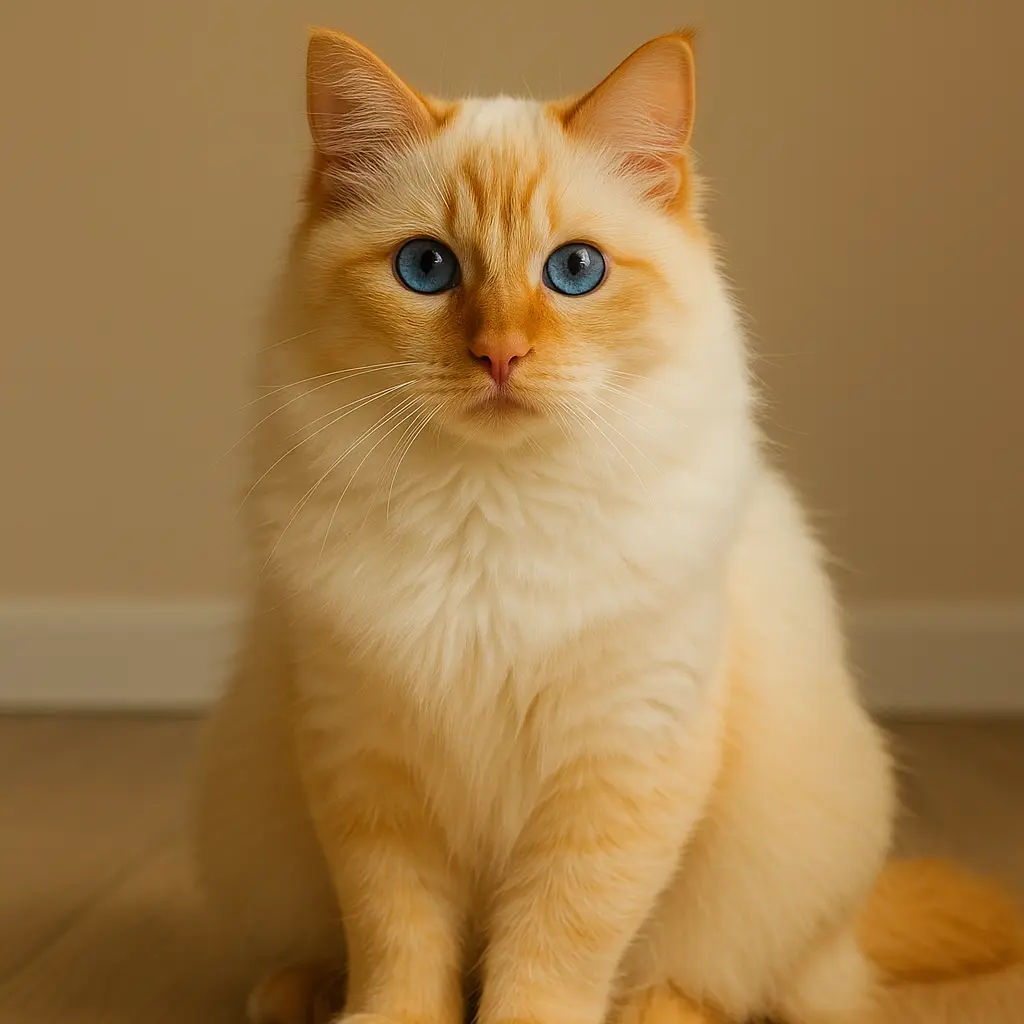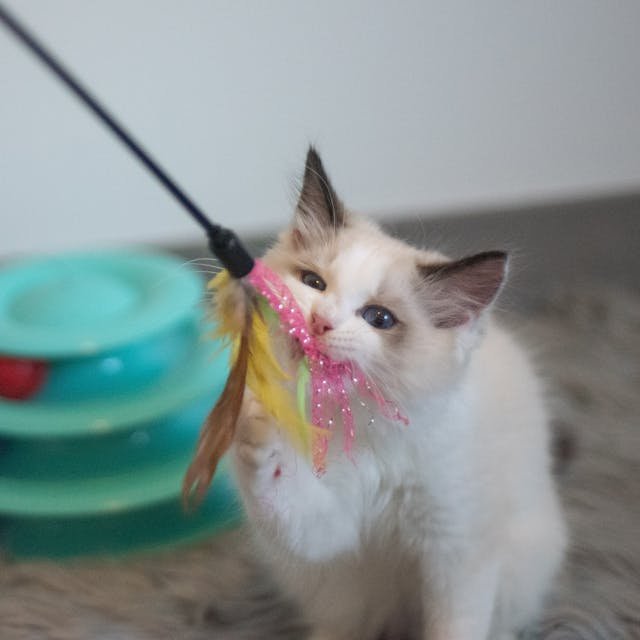
when you liked cats with amazing colors and gentle temperaments, the flame point ragdoll might steal your attention. These cats stand out not only for their warm-toned fur but also for their calm and affectionate nature. While the name might sound intense, their personality is anything but.
Let’s delve into the unique features of the Flame Point Ragdoll, how it compares to similar types, and what to expect if you’re considering bringing one home.
The Flame Point Ragdoll Cat
The Flame Point Ragdoll is a variation of the Ragdoll breed, characterized by the color “points” — specifically, the ears, face, paws, and tail — that are red to orange. These cats have creamy white color bodies that contrast beautifully with their vibrant extremities.
This coloring doesn’t happen randomly. It’s the result of temperature-sensitive pigmentation influenced by a specific gene. Cooler areas on the cat’s body develop richer color, which is why their ears and tails appear more saturated.
What makes these cats even more appealing is their classic Ragdoll nature: they’re laid-back, social, and tend to go limp when held — hence the name “ragdoll.”
Flame Point Ragdoll Body / Colour
The body of a flame point ragdoll is typically a soft, creamy white. Their flame-colored fur ranges from dark red to light orange, with a white or cream torso. The points — the ears, tail, face, and sometimes legs — carry those distinctive warm hues.
The paw pads are usually light pink, a charming little detail that adds to their visual appeal. Their eyes? Striking blue — just like all purebred Ragdolls.
Interestingly, these cats can change color slightly depending on environmental temperature. In colder conditions, their color points can deepen. Warmer weather may lighten them. It’s not magic — it’s biology.
The Flame Lynx Point Ragdoll Cat
The Flame Lynx Point Ragdoll is a patterned variation that combines flame coloring with tabby-style stripes. Instead of solid points, you’ll see red bars or rings across the face, legs, and tail, along with white facial highlights.
This cat’s ears often display a deep red hue, while its paw pads can lean toward coral pink. The tabby overlay doesn’t take away from the soft look; it adds texture and character.
You’ll often find the lynx pattern accompanied by the typical blue Ragdoll eyes and a soft white base coat.
Flame Lynx Mitted Ragdoll
A flame lynx-mitted ragdoll includes everything you just read — plus white “mittens” on the front paws and boots on the back ones. These white markings are symmetrical and set against orange legs and a soft orange face.
This version of the Flame Point maintains a bicolor Ragdoll color structure, but the mittens make it instantly recognizable. The pattern gives off a polished, well-dressed look that many find irresistible.
They retain the same temperament: easy-going, cuddly, and quite content to be carried like a plush toy.
Flame Bicolor Torbie Ragdoll
The Flame bicolor Torbie Ragdoll is a fusion of traits. It blends the seal point ragdoll structure with flame coloration and torbie patterning — a mix of tabby and tortoiseshell.
This combination is rare. You’ll find tabby striping, tortie speckles, and the classic Ragdoll point layout, all in one cat. Their facial blaze often forms an inverted white “V” shape, and they typically have white legs and underbellies.
If you’re looking for a truly one-of-a-kind cat, this might be it. Not many breeders specialize in this combination due to its complexity.
Are Red Point Ragdoll Cats Rare?
Yes — red point ragdolls are considered relatively rare. Among the six primary color points in the breed (seal, blue, chocolate, lilac, cream, and flame/red), flame point is one of the least common.
The lilac point and chocolate point Ragdolls are rarer, but flame ranks close behind. It’s not unusual to search for months before finding a breeder with redpoint kittens available.
Blue point ragdolls remain the most widely seen — especially across North America — which makes red and flame even more desirable for those looking for something unique.
What is the Difference Between Red Point Ragdoll Cats and Flame Point Ragdoll Cats?
There’s no difference at all. Both terms describe the same coloration. “Redpoint” is a more technical term, whereas “flame point” is the preferred phrase used by organizations like the Cat Fanciers Association (CFA).
So whether you say red point ragdoll or flame point ragdoll, you’re referring to the same striking cat with reddish-orange point markings and a white base coat.
Some breeders may choose one term over the other in listings, but it’s purely a naming preference — not a distinction in genetics or appearance.
Do Red Point Ragdolls Come in Lipstick Red?
No, not even close. The term “red point” can be misleading. These cats do not come in a true lipstick red. Instead, their points fall on a spectrum from light orange to a soft, reddish-apricot.
Their colors are subtle, not bold or saturated like a cherry or crimson red. Even the deepest flame points have more of a warm orange undertone than a vibrant red one.
If you’re expecting vivid scarlet — this isn’t it. The coloration stays in the natural, muted flame range, resembling the tip of a candle flame.
Can Ragdolls Be Orange?
Yes — but not in the traditional sense. The orange tone you might see on a flame point ragdoll isn’t the bright, pumpkin orange found in cartoonish depictions.
Instead, it’s a soft, reddish-orange. Sometimes, it’s closer to apricot or peach. This coloring appears only on the points: the face, tail, ears, and sometimes legs. The rest of the body stays a pale white or cream.
The orange shade is subtle, layered, and temperature-dependent. You won’t find a Ragdoll that’s entirely orange from head to toe — that’s not how their coloring genetics work.
Are Red Point Ragdolls Born Red?
No, red point ragdolls — like most Ragdolls — are born solid white. Their color points develop over time, usually within the first few weeks to months.
By the age of 8 to 12 weeks, you might start to notice a faint orange tint on the ears or tail. Full coloration can take up to a year, sometimes even longer.
This delayed color development is linked to a temperature-sensitive enzyme that only activates after birth, resulting in pigment formation in cooler areas of the cat’s body.
So, if you’re trying to spot a Flame Point kitten in a newborn litter — you’ll have to wait. The white fluff won’t give it away right away.
Final Thoughts
The Flame Point Ragdoll is more than just a pretty face. Between its glowing colors, signature blue eyes, and relaxed personality, this cat has everything you’d want in a companion.
Whether you’re drawn to the flame lynx pattern, the mittens of a mitted variation, or the intricate markings of a torbie, there’s a version of this Ragdoll to match your taste.
Just remember — color isn’t the only factor. These cats are known for their loyalty, softness, and affection. If you meet one, chances are, you’ll be hooked.

